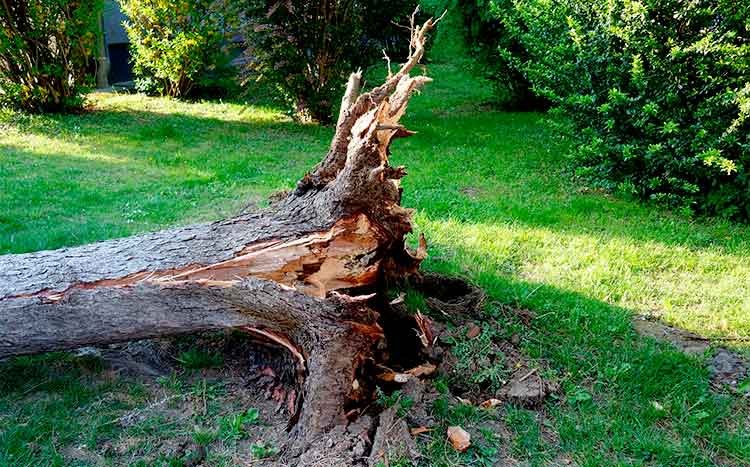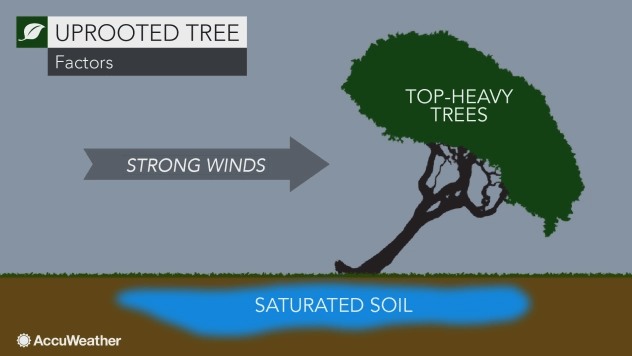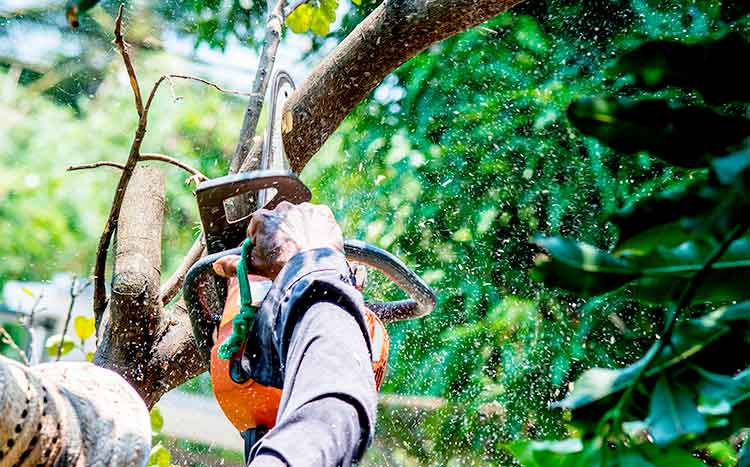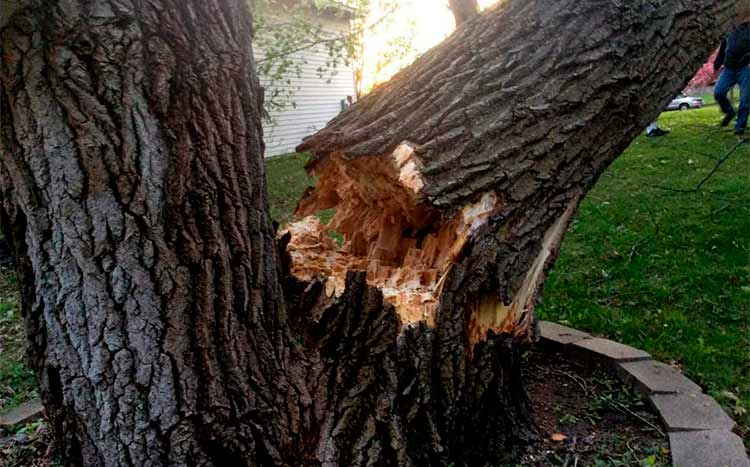Many homeowners are keen to figure out the reasons behind and the timing of a tree’s sudden collapse. This inquiry turns even more perplexing when considering why certain trees withstand the storms whereas others do not.
While aging and external factors such as strong winds and hurricanes play a significant role in affecting their strength, there are often more reasons than meets the eye.
Here’s a quick look at some of the key things you should know.

What we cover
ToggleCommon reasons for trees falling
A few of the most common reasons why your tree is falling include:
- Soggy soils
Since most roots are only 18 – 24 inches1 below the ground, an overload of rain followed by a strong wind can easily uproot the tree.
- Weak or damaged root systems
Tree root systems can be easily damaged from construction or landscape installations too deep into the soil. Younger trees may also have shallow or weak, underdeveloped roots, which makes them more susceptible to falling over.
- Decay and insect infestation
Insect infestations2, including fungi that cause tree decay, damage the internal tissues and wood of the tree. This reduces its structural stability, and after some time, the tree may fall.
- Construction damage
Any construction on your property also affects the trees nearby. Activities like putting up your driveway or digging utility lines near the trees damage the shallow roots and may even starve them. As a result, the trees become destabilized and thus may easily fall.
- Additional factors
Other factors that may cause the tree to fall include:
- Flooding
- Malnutrition
- Improper planting conditions
- Weak branch unions
Signs that indicate that your tree may fall
While it’s impossible to predict precisely when a tree may tumble down, there are some signs that could inform you when it’s more likely to happen. Some common signs to look for include:
Sign 1: Several dead branches
This is probably the easiest sign to spot. You can know a dead branch by simply plucking a small branch and checking the interiors. If it’s dark-toned, part or the whole of that tree may be rotting.
To be safe, hire a tree surgeon to look at it, as it could come down at any time.
Sign 2: Excessive leaning
Any tree leaning at an angle greater than 15 degrees may indicate root or wind damage. Moreover, trees that lean facing East are also more likely to fall since the wind blows from the west.
In such a case, it may need immediate removal to avoid any damage when it falls. Keep in mind, trees that naturally grow leaning to one side may not be dangerous.
Sign 3: Hollow spots in the trunk
A hole in the trunk of a tree usually indicates signs of decaying as a result of poor pruning practices. While this may not always mean that the tree is falling, large hollows may result in tree instability that can cause it to fall.
However, if there’s adequate solid wood around the trunk, the tree may not tip over.
Sign 4: Patches of missing barks
If you notice some patches of missing barks, usually called cankers, that’s also a big sign that the tree is falling. There’s a high probability of the tree breaking at that point whenever there’s a high wind or storm.
Deep cracks on the trunk should also be a huge red flag as it indicates weakness.
Sign 5: Leaves falling close to the trunk
Leaves shouldn’t be falling closer to the tree’s trunk first. Trees in good condition should always shed the outer branch leaves first. In case you’ve noticed a lot of random shedding near the trunk, that could indicate a falling tree.
Sign 6: Fungi Growth on the roots
Fungi at the tree’s base are a key indicator of rotting and decaying roots. The widespread growth of the fungi shows the extent of this damage to the roots. Over time, the tree becomes too unstable, and a light wind, flooding, or hurricane can easily push it down.
Does the height affect trees’ falling?
Unfortunately, yes. Taller trees with canopies are more susceptible to falling than shorter trees. This is because for trees, the root and trunk act as the fulcrum whenever any force is applied by elements like wind, rain, or snow.
As such, the force applied to the roots increases with the height. Therefore, at some point, the force will be too much, and the tree will break and fall.
Shorter trees, on the other hand, don’t exert a lot of force on the roots making them withstand heavy winds and storms.

Why do trees topple in high winds?
According to most tree experts, trees fall under high winds mainly because of the condition of their roots. As the wind gets stronger, the resulting air pressure decreases, creating an upthrust force.
If the roots are shallow, weak, or compromised in any way, the upthrust force pushes it up, uprooting it. The same may happen for trees on rain-saturated grounds.
Typically, the critical wind3 speeds that might cause this impact stand at 90mph.
Is proper trimming essential in avoiding damage?
Yes! Even though the impact of proper trimming isn’t visible immediately, it’s crucial in preserving the health of the tree.
Trimming removes the dead and insect-infested branches early, resulting in improved tree growth. It also prevents the tree overgrowth which makes it weaker and limits its survival chances.

Does overwatering affect tree falling?
Yes! Overwatering your trees can easily result in the roots rotting. This is because the surplus water reduces the air pockets in the soil, and thus the roots can’t get adequate oxygen. In turn, they become weak and more susceptible to falling.
Overwatering may also result in stunted growth of the tree. To avoid this, only water the tree when the soil feels damp.
What amount of rain makes the soil wet enough that roots can come undone?
The tree amount of rain required to uproot trees will mainly depend on the soil type in an area. Nonetheless, most areas recognize rains greater than 4mm or 25 inches per hour to be heavy enough to uproot the tree roots.
What role does the type of soil play?
Different soils have varying water retention rates. For instance, clay soils are more compact and retain more water for longer periods than sand or loam soils. This means that such soils remain overwatered and can therefore result in the rotting of the roots.
Sandy soils drain water very quickly, and therefore, the tree doesn’t receive enough water or nutrients unless it has very deep roots. The sparse nature of the soil makes it unstable and very easy to topple over.
Loam soil, on the other hand, provides a good base for root development and nutrition absorption. It retains water long enough for the roots to absorb the required amount of water and nutrients.
The compact nature of the soil also makes it very stable and much harder to uproot a tree on this soil.
Is there any way to test the tree if there is a risk of falling?
The best way to go about a risky tree is by consulting an arborist or other tree expert. However, if you don’t have the time for this, you can easily test the tree risk of falling by:
- Cut a branch of the tree and look at the interiors. If they are dark-colored, that’s an indication that the tree roots may be rotting. It could fall at any time.
- You can also test the strength required to break a branch from the tree’s trunk. If it’s very easy, that might indicate that the tree’s health is failing. As such, it’s more likely to fall.
Urban trees vs. trees in nature
Unlike the trees in nature, urban trees4 demand a lot of extra maintenance. The urban soils are more compact and have fewer nutrients than wild trees, which means the trees need more watering.
Consequently, the trees develop very strong and thick canopies, which can easily take the tree down during heavy winds or storms.
Urban trees are also affected by construction damages whenever any new structures are being installed.
FAQ's
You should be concerned about a tree falling whenever you notice any unusual signs like dead and falling branches, excessive leaning, fungus growth near the roots, and cracks on the trunk, among others.
The best way to protect yourself is by staying safe. Always inspect your trees after each storm and eliminate any unstable trees early. Additionally, maintain a regular tree maintenance habit to improve its health.
Many factors determine why a tree falls. In most cases, it’s usually dependent on the root’s system and the condition of the soil. Therefore, trees will mainly fall during storms and heavy winds if the roots are damaged, or the soil is overwatered.

- B.C. Scharenbroch, L.A. Roman, E.G. McPherson, J. Bartens, and D. Boyer, (2014) Urban Tree Growth and Longevity. <https://www.fs.usda.gov/nrs/pubs/jrnl/2014/nrs_2014_scharenbroch_001.pdf> Accessed: 16-03-2024.
- Gary W. Moorman, (2023) Tree Diseases that Create Hazards. <https://extension.psu.edu/tree-diseases-that-create-hazards> Accessed: 16-03-2024.
- E. Virot, A. Ponomarenko, (2016) Critical wind speed at which trees break. <https://journals.aps.org/pre/abstract/10.1103/PhysRevE.93.023001> Accessed: 16-03-2024.
- Hannah Safford, Elizabeth Larry, E. Gregory McPherson, David J. Nowak, Lynne M.Westphal, (2023) Benefits of Urban Forests. <https://www.climatehubs.usda.gov/sites/default/files/Urban-Forests_CCRC.pdf> Accessed: 16-03-2024.












